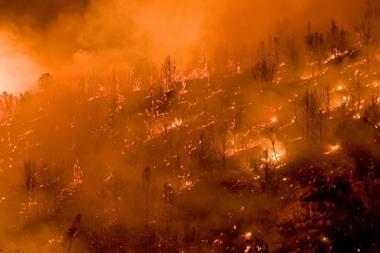Leaders from across the political, economic, environmental and risk sectors gathered in Bermuda in May for the first Ocean Risk Summit

The Ocean Risk Summit sought to identify potential exposures to ocean risk, to prepare to tackle its broad-ranging consequences. StrategicRISK caught up with Chip Cunliffe (pictured), sustainable development director at specialty insurer XL Catlin, to find out more.
SR: What are the trends behind the oceanic environment changing so fast, and why is it so important to us?
CC: Scientists are telling us that the ocean is changing at the fastest rate in 65 million years. Since 1955, over 90% of the excess heat trapped by greenhouse gases has been stored in the oceans, with the upper 700m of ocean dominating the energy take up. If that energy had gone into the lower 10km of the atmosphere, then the Earth would have seen a warming of 36 Celsius. Given this, we are starting to see changes not only to the marine ecosystem, but we’re also seeing the ocean driving significant changes too.
For instance, as water warms, it expands. Sea levels are rising on average at 3mm a year. Combined with an increase in intensity of tropical cyclones from the energy stored in the upper reaches of the ocean, storm surges are likely to become more damaging, leading to flooding and damage to assets, as well as business interruption. It could also affect our day to day living by contamination of fresh water sources, degradation of agricultural land and impact on human health.
In 2011, about 90% of fish stocks were either fully fished or overfished in nearly all areas of the world. Fish are moving pole-wards as they seek waters optimum for feeding and breeding, creating potential food security issues and impacting local livelihoods. Water borne diseases, such as vibrio, that causes cholera, are more easily spread in warmer waters.
At a press conference on the eve of the Ocean Risk Summit, Charles Cooper, chief executive of reinsurance at XL Catlin, the global brand used by XL Group’s insurance and reinsurance companies, said: “Ocean risk is among the biggest challenges we face, but with the right approach, we can incentivise positive change, to protect our planet now and into the future.” And he was right.
SR: What actions are most needed from a governmental policy and regulatory perspective, to help offset/mitigate the risks?
CC: Managing and mitigating ocean risk is not something that can be done alone. The outputs from the Ocean Risk Summit made it clear that a holistic, multi-sectoral approach is required.
As the Ocean Risk and the Insurance Industry report by Falk Niehörster, director of Climate Risk Innovations, and commissioned by XL Catlin, suggests, the insurance industry can support risk transfer in developing countries and play a critical role in increasing large-scale global resilience by developing innovative insurance solutions. These solutions could involve public-private partnerships (PPPs) at a sovereign level via multi-national climate change agreements that increase resilience to cascading effects of ocean warming and climate change.
One such example is the newly launched pilot project in Mexico between the local government, hotel industry, The Nature Conservancy and Swiss Re, where private and public capital is used to monitor, maintain and protect the coral reef ecosystem that protects hotels near the seafront. Any insurance payouts would then be used to fund restoration of the reef after damage from extreme events.
Given the need to close the protection gap, it would make sense that governmental policy supported the creation of PPPs or otherwise encouraged the development of innovative solutions in order to monitor and protect ecosystems that provide natural protection and increase resilience for local communities most at risk from the hazards of ocean change.
SR: Are some sectors more at risk than others?
CC: The global economy is increasingly reliant on the resources and services provided by the ocean, as well as its regulating effect on our climate system. The so-called “blue economy” has a gross marine product of at least $2.5trn, with an underlying asset value of $24trn.
The Organisation for Economic Cooperation and Development (OECD) suggests that the blue economy will double in size by 2030, creating opportunities for business and finance around the world.
There is a cross-section of sectors that will be directly and indirectly impacted by ocean risk. Those directly impacted include the aquaculture industry, the shipping industry - including ports - the tourism industry - including at risk hotels on coastlines - and the renewable energy sector.
In the insurance industry, sectors covered by specialty lines have also been impacted, for example, the 2016 algal blooms and aquaculture fish kills in Chile due to a strong El Niño pattern resulted in potential losses of up to $800m.
Recently, the World Meteorological Organization (WMO) confirmed that 2017 was the most expensive year in history in terms of losses from weather and climate-related events, costing the global economy an estimated $320bn.
Those indirectly impacted include countries and companies that will be impacted by weather system changes. For instance, Puerto Rico’s pharmaceutical industry was halted as electricity was wiped out for the entire island in the aftermath of Hurricane Maria. A total of 50 plants were impacted with short-term impacts on drug supplies.
Over 90% of the world’s goods are transported across the ocean. As weather systems change, impacts to coastal ports from increased intensity of storms and sea level rise will likely affect global supply chains.
SR: Which geographies and economies are at most immediate risk, examples please…and is it too late?
CC: The geographies and economies most at risk are those least able to adapt. As little as 26% of overall economic losses caused by natural disasters worldwide during 2016 were covered by insurance, yet research shows that a 1% increase in insurance penetration can reduce the disaster recovery burden on taxpayers by 22%.
Insurance, and in particular micro insurance, could therefore play a vital role in transferring risk away from the governments of countries that can ill afford to pay.
What are some of the resilience threats and interlinkages that risk managers might not have considered when it comes to the world’s oceans?
A new report by IUCN (International Union for Conservation of Nature), commissioned by XL Catlin, warns of unprecedented changes occurring in the ocean and points to the pressing need for a multi-sectoral approach, with businesses, government and the insurance industry working together to address their potential impacts.
The IUCN report, Ocean connections: An introduction to rising risks from a warming, changing ocean, examines the impacts of changes to the ocean and their potential consequences for society.
Ocean warming will affect global food security as a result of changes in fishery yields and the distribution of fish stocks. Damages to property and the displacement of people are expected to rise as a result of sea-level rise and frequent extreme weather events such as storms and floods. The health of marine species and humans will be affected by increasing bacteria and virus outbreaks as pathogens spread more easily due to the warming waters, while travel and tourism will be impacted by frequent coral bleaching events.
What is XL Catlin’s commitment to mitigating ocean risk?
In 2017 XL Catlin launched its Ocean Risk Initiative to help identify solutions and build resilience at local, regional and global levels to the implications of ocean-related risk.
Last week, XL Catlin launched two reports on Ocean Risk. The first, “Ocean connections: An introduction to rising risks from a warming, changing ocean”, co-authored by Dan Laffoley and John Baxter, under the aegis of the IUCN, examines the impacts of changes to the ocean and their potential consequences for society.
The second, “Ocean Risk and the Insurance Industry”, by Falk Niehörster, director of Climate Risk Innovations, highlights the need for the insurance sector to both ready itself for the far-reaching impacts of ocean change, but also stresses the opportunity that the insurance industry has to incentivise targeted mitigation strategies The report calls for new modelling systems to understand multiple, interconnected ocean risks, and for governments to assess the real value of their coastal and ocean assets.
XL Catlin, alongside its partners, hosted the first Ocean Risk Summit in Bermuda from 8-10 May. The Summit highlighted the role the insurance industry, alongside multilateral agencies and the private and public sectors, can play to reduce our vulnerability to the multiple threats linked to the changing ocean, and provoked creative debates to accelerate the search for solutions.
During the Summit, XL Catlin announced a partnership project with the Stimson Center’s Environmental Security program, to create a predictive mapping model that will help identify the developing coastal nations that are most at risk from climate change. The model will help better predict the hazards and identify where resilience measures should be implemented in those regions most vulnerable to these changes.
XL Catlin also announced a partnership with The Nature Conservancy to explore the creation of a market for “Blue Carbon Resilience Credits”. Mangroves, salt marshes, coastal wetlands and sea grass beds store up to five times more carbon than terrestrial forests, but also provide a natural barrier to powerful waves and storm surges in extreme weather. Assigning a market value that reflects both the carbon storage and coastal protection benefits provided by this natural infrastructure, could allow insurance companies and other businesses to offset their carbon footprint at the same time as increase the resilience of local communities most at risk from climate change impacts.




















No comments yet